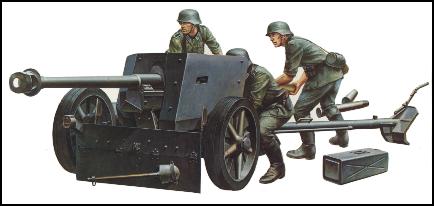
Anti-Tank Weapons
 |
German troops used a wide verity of anti-tank weapons during the war,some captured from the enemy and others of futuristic design.In 1939 the standard anti-tank gun with which the German Army went to war was the 3.7 cm PaK 35/36.PaK was the standard abbreviation for PanzerabwehrKanone , or anti-tank gun.Small light and relatively easy to handle the PaK 35 was far from ideal for dealing with the larger and more powerful armored vehicles then coming into service.Indeed its crews ruefully called it the 'door knocker' because of its poor performance.Attempts to enhance penetration included the use of tungsten shot and a fin-stabilised muzzle-loaded hollow charge grenade , the Stielgranate 41.The PaK 35 had a maximum range with HE ammunition of 4,025 meters and could penetrate 36mm of armour, at 500 meters with conventional ammunition or 180mm at 300 meters with the Stielgranate 41.Over 20,000 guns were built during the war. Aware of the deficiencies of the PaK 35/36 the German Army Demanded a larger calibre weapon.Developed from 1938 the 5cm PaK 38 entered service late in 1940.The PaK 38 had a maximum range of 2,652 meters with HE ammunition.With tungsten shot it could pierce 55mm of armour at 1,000 metres.The appearance of heavily armored Soviet T-34 and KV-1 tanks gave a new urgency to anti-tank gun design and two new 7.5cm guns were developed , the PaK 40 being manufactured by Rheinmetall-Borsig and the PaK 41 produced by Krupp entered service.Both were fairly powerful , though the PaK 40 was effectively scaled up version of the PaK 38 , and the more advanced PaK 41 was a superiorweapon.The Krupp design was one of the first 'cone' or 'squeeze bore weapons to enter service.The internal bore of the barrel tapered slightly from breech to muzzle.The pressure behind the Pzgr Patr 41(HK)tungsten shot increased as it travelled down the barrel and it emerged with a muzzle velocity of 1,125 m/s.The shell consisted of a light ballistic cap behind which was a tungsten carbide shot.The shot was enclosed in an outer case with flanges at the center and base.The flanges were compressed as the shell passed along the barrel. The penetrative power of the advanced new weapon was remarkable ; the PaK 41 could punch through 145mm of armour at a range 1,000 metres.Fortunately for the Allies there was a shortage of tungsten in Germany.Another problem was barrel ware : the high pressures meant that the gun tube had to be replaced every 500 rounds.Eventuallyonlyy 150 PaK 41's were built. |
|
|
| Above : The standard German anti-tank gun at the outbreak of war was the 3.7cm PaK35.Designed in the 1920s it was a light and handy weapon , though in 1940 its crews found that it could not deal with the thick armour of British and French infantry tanks. |
|
|
| Above : The key to the success of the Eighty-Eight was the very high velocity of its shells.It could damage most Allied tanks even when firing high explosive rounds and with armour-piercing shot it was lethal.Curiously the German were the only nation which used heavy dual-purpoe weapons : most Allied armies had comparable anti-aircraft guns but these were never used to engage ground targets. |
|
|
German Infantry anti-tank hand held weapons
|
However even if the weapon was effective and well designed it needed a gunner or crew with steady nerves to wait until a tank was within effective range before they opened fire.On 13 February 1943 a 20-year old Dutchman single-handedly knocked out 13 Soviet tank's with his French made PaK 97/38 during the attack in the Lake Ilmen area.Gerardus Mooyman a volunteer with the Waffen-SS Freiwilligen-Legion Niederlands became the first non-German to be awarded the Knight's Cross of the Iron Cross.By his own admission however Gerardus was a rather unenthusiastic soldier and was sulking in a bunker when the Soviet forces attacked.A German officer attached to the Dutch Legion practically dragged him out by his ear and the angry young Dutchman vented his fury on the advancing Soviet armour. |